1. Define environmental and physical ergonomics. What are two types of anthropometry, and how is the data used?
2. What is the rationale for Universal Design? List the seven principles of UD.
3. What’s the problem with standards?
4. How has human-computer interaction (HCI) changed with advances in technology?
5. What is ecological interface design? How does the SRK model relate errors to types of performance?
6. What problems did Y2K pose, and what were the effects? How can a foreseen problem be dealt with in advance?
Environmental ergonomics includes consideration of lighting, noise level, vibration, temperature, relative humidity, and air quality on human performance
Kingma & van Marken Lichtenbelt (2015): environment & comfort
- thermal comfort depends on four _____________ factors: air temperature, mean radiant temperature, air velocity, and relative humidity
- and two ________ factors: clothing, and metabolic rate (rate of energy expenditure)
- metabolic rate depends on: size, weight, age, fitness level, and the type of work being done
- however, temperatures in office environments are based on standards developed in the 1960s (ASHRAE Thermal Environmental Conditions for Human Occupancy)
- this standard is based on the metabolic rate of a 40-year-old, 154-lb male (60-70 W/m2)
- model overestimates the heat production of women by up to 35%
- result: a typical woman in a typical office environment will not be in the _____________ zone
Physical ergonomics focuses on human anatomical, anthropometric, physiological, and biomechanical characteristics in workplace design
- goal: create working environments that match people’s capabilities
- specific concerns include workplace layout, working postures, repetitive movements, work-related musculoskeletal disorders (MSDs), materials handling, and physical safety and health
_____________: measurement of human body and its biomechanical characteristics (mechanical capabilities of human skeleto-muscular systems)
- people are not all the same size:
design system to fit only one person ![]() few others would be able to use it
few others would be able to use it
- poor design for mechanical abilities of the human body can lead to discomfort or ______
e.g., repetitive strain injuries (RSIs)
e.g., ______ ______ syndrome (CTS): inflammation and swelling in the tendons that run through the narrow carpal tunnel in the wrist, compressing the median nerve; causes pain, numbness, and tingling in the fingers
• ______ measures:
- passive dimensions of human body
- used to determine size/spacing requirements of workspace
e.g., height, weight, seat-to-elbow height
• _______ measures:
- dynamic, changing properties of human body
e.g., strength, endurance
- used to match dynamic characteristics of controls to user
e.g., strength of fingers, force of leg pushes, range of motion for various joints
The measure of man: Human factors in design (Dreyfuss, 1960; Tilley & Henry Dreyfuss Associates, 2001):
- landmark collection of ergonomic reference charts first published in 1960
- provided precise specifications for product designs via “Joe” and “Josephine” anthropometric diagrams
________ standards:
- developed by U.S. Department of Commerce’s National Bureau of Standards
- currently used database for women’s sizes 2-20 (PS 42-70) based on a 1941 anthropometric study of women in ________
- not representative--______ towards young, unmarried white women
- _______ of fit is rare; model may be hired
- vanity sizing: nominal size has become larger over time
How to use anthropometric data (Chapanis, 1996):
• use measurements from intended __________
• use representative data
e.g., Asians vs. North Americans
e.g., 5th percentile torso length & 5th percentile head height do ___ equal 5th percentile stature
• age differences
• sex differences
• effects of ________
• changes over time: due to diet/habit, there are changes in size/fitness of population
e.g., 95th percentiles:
- in 1962: 199 lbs. for women, 217 lbs. for men
- in 2000: 226 lbs. for women, 244 lbs. for men
- in 2018: 263 lbs. for women, 284 lbs. for men (also height increased by 1 inch for women, 1.2 inches for men)
e.g., seats in Comerica Park in Detroit (built in 2000) are 5 cm wider than those in the old Tiger Stadium
• design options:
▸ one size fits all
▸ make several sizes
▸ standard: design to fit 5th to 95th ___________ of population
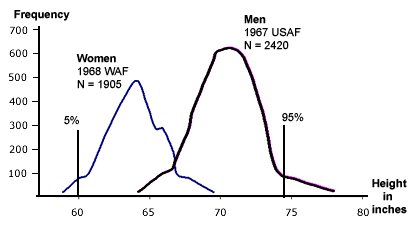
▸ make design __________:
- best if adjustment only needs to be done once
- user may not make difficult/frequent adjustments
• incorporate dynamic measures
• ____ the design
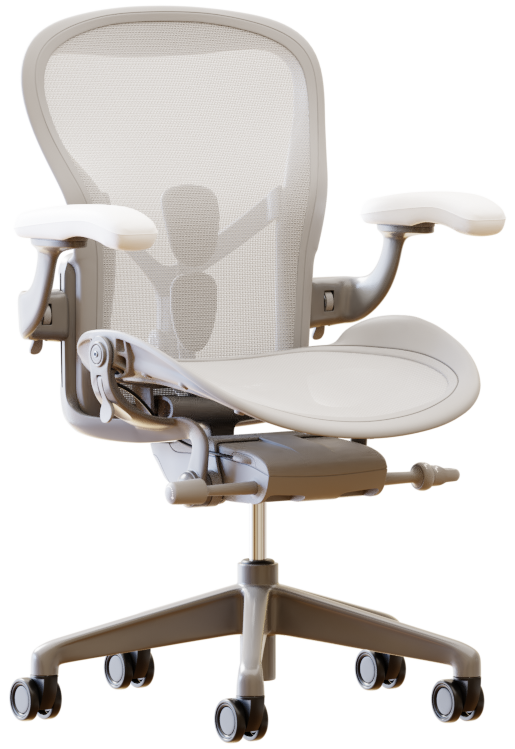 |
- first made by research and design firm Herman Miller in 1994; redesigned in 2016 - has won numerous design awards - widely considered very comfortable and extremely __________ - also regarded as highly _________ (installed in the New York Museum of Modern Art’s permanent collection) - structure: • made mostly of recycled materials • seat and back made from “Pellicle®” (thin skin or membrane): synthetic, flexible mesh • “waterfall” front edge reduces pressure on thighs, increases circulation • Kinemat® tilt allows forward tilt-to-backward recline • comes in three different sizes • can be customized with different modules, including armrests, bases, and PostureFitTM kit (gives custom-fitted support to the ______: base of the back where the spine meets the pelvis) |
- design process:
• conducted ______________ studies (measuring popliteal height, forearm length, etc.)
• did pressure mapping and thermal testing of Pellicle®
• design evaluated by ergonomists, orthopedic specialists, and physical therapists
• performed _____ studies with representative sample of 224 people (determined chair size preference is most strongly related to height and weight)
• tested with users
- criticisms:
![]() _________: around $1,000
_________: around $1,000
![]() difficult to ______
difficult to ______
![]() atypical contact of chair on back is uncomfortable
atypical contact of chair on back is uncomfortable
![]() Pellicle® not as soft as foam cushion/edges of chair frame are too hard
Pellicle® not as soft as foam cushion/edges of chair frame are too hard
“The design of products and environments to be usable by all people, to the greatest extent possible, without the need for adaptation or specialized design.” (Mace, 1985, p.147)
- a.k.a. inclusive design, design for all, barrier-free design
- rationale:
• in the US, 85.3 million people have some level of __________; 55.2 million have severe disability (U.S. Census Bureau, 2018)
• in Canada, 8.0 million have a disability; 3.2 million have severe or very severe disability (Statistics Canada, 2024a, 2024b)
• demographic shifts: the population is living 30 years longer than 100 years ago
• prompted by ___________ in Australia, Canada, the UK, and the USA (e.g., Section 508)
• barriers are not in the person but in the environment; appropriately designed environments remove those barriers
Principles & Guidelines (Story, Mueller, & Mace, 1998):
1. _________ use: can be used by people having diverse abilities
a) provide the same means of use for all users
e.g., automagic doors
b) avoid segregating or stigmatizing any users
e.g., diaper-changing station in _____ room
c) ensure privacy, security, and safety equally to all users
e.g., text with 911 service
d) make the design _________
e.g., OXO Good Grips™
2. ___________ in use: accommodates a range of individual preferences and abilities
a) provide ______ in methods of use
e.g., ramp or stairs
b) accommodate right- or left-handed use
e.g., ambidextrous scissors
c) facilitate user’s ________
e.g., big-button keys
d) provide adaptability to user’s ____
e.g., speed control on voice mail
3. ______ ___ _________ use: easy to understand, despite user’s experience, knowledge, language skills, or concentration level
a) eliminate unnecessary __________
e.g., single-lever faucet
b) be consistent with user expectations
e.g., Mercedes-Benz seat control
c) accommodate a wide range of literacy and language skills
e.g., IKEA® assembly instructions: ________ only
d) arrange information consistent with its importance
e.g., instructions on inside of washer lid
e) provide effective prompting and ________ during and after task
e.g., computer displays operation progress
4. ___________ information: necessary information is communicated to the user, regardless of ambient conditions or sensory abilities
a) use ________ modalities (pictorial, verbal, tactile) for redundant presentation of essential info
e.g., visual/auditory/tactile thermostat
b) maximize “__________” of essential information
e.g., contrast between lids and bowls
c) differentiate elements in descriptive ways (i.e., make it easy to give ____________)
e.g., audio plugs/jacks have different colours
d) make devices compatible for people with sensory limitations
e.g., closed captioning
5. Tolerance for _____: minimizes hazards and adverse consequences of accidental/unintended actions
a) minimize hazards and errors
e.g., Bagel Guillotine®
b) warning of hazards/errors
e.g., Mr. ___ stickers on poisons
c) provide ____ _____
e.g., “undo” software function
d) discourage unconscious action in tasks requiring vigilance
e.g., “_______” handle on lawnmower
6. Low ________ effort: can be used efficiently and comfortably with a minimum of fatigue
a) allow user to maintain a neutral body position
e.g., Incase Ergonomic Keyboard
b) use reasonable operating forces
e.g., lever handles on doors
c) minimize __________ actions
e.g., speech recognition
d) minimize sustained ________ effort
e.g., Travelpro® Rollaboard® luggage
7. ____ and _____ for approach and use: user is not restricted by body size, posture, or mobility
a) provide clear line of sight to important elements for any user
e.g., _______ counters
b) make reaching to components comfortable for any user
e.g., _____-_______ controls on KitchenAid® range
c) accommodate variations in hand and grip size
e.g., open-loop door hardware
d) provide adequate space for the use of _________ devices
e.g., wide gate at subway station
Pros & Cons:
![]() accommodates all people,
regardless of ability
accommodates all people,
regardless of ability
![]() increasingly in widespread
use
increasingly in widespread
use
![]() criticized as vague, difficult to understand
criticized as vague, difficult to understand
![]() industry requires ways to measure performance to evaluate their designs against UD principles
industry requires ways to measure performance to evaluate their designs against UD principles
 |
International Organization for Standardization (derived from Greek word isos, meaning “_____”) |
- international organization that develops thousands of voluntary standards
e.g., environmental management, ergonomics, food safety, shoe sizes, etc.
ISO 9000 family
- represents __________ process standards
- requires that management document every process and job description
- certification is often viewed as a criterion of quality
- but is not a product _______ label or guarantee
- question asked:
Do _________ match specifications?
- questions not asked:
Do ________ match specifications?
Are processes useful and effective?
HCI comprises three components: the user, the computer, and the ways they interact.
Components of a computer system:
• ________: microprocessors, desktop computing
• software: “killer apps” like Lotus 1-2-3
• ____ _________ (“UI”): mostly part of operating system; determines how person interacts with the computer
The computer reaches out: The historical continuity of interface design (Jonathan Grudin, 1989)
The five levels of human-computer interface development:
1. The interface at the ________ (1950s)
- first users: engineers who built the computers
- have intimate knowledge of hardware; no need to “learn” how to use it
- use is awkward: binary vs. hex code vs. decimal:
e.g., 10111001 vs. B9 vs. 185
- improvements made in interface design:
• better hardware
• better, more meaningful arrangement of switches
• distance programming from hardware (e.g., use English, decimal numbers)
2. The interface at the ___________ task (1960s-1970s)
- primary users: programmers
- learning is highly specialized, formalized
- improvements made:
• more high-level languages
• better operating systems
• interactive terminals
3. The interface at the ________ (1970s-1990s)
- primary users: not computer experts, professionals, hobbyists
- importance of usability grows; goal: reduce training
- PCs, desktop computers overtake mainframes/terminals
- development focuses on these systems
e.g., Macintosh
- perceptual, cognitive factors of interface are examined
- improvements made:
• increase end-user efficiency
• apply computers to more types of tasks
4. The interface at the ___________ dialogue (1980s-)
- people use computers, not realizing they’re “computers”
- computer begins to expand to real world; leads to convergence with other media
e.g., graphics, sound, video are digitized
- more integration with cognition, problem-solving, speech recognition, etc.
- computers begin to learn about people--instead of always vice-versa--via neural networks
- improvements made:
• greater ease of use (for individuals)
• greater communication via computer (e.g., internet)
5. The interface at the ____/______ setting (1990s-)
- computers ubiquitous; everyone a “user”
- computers integrate into social situations, workplace
- most computers are networked, not isolated
- improvements:
• greater ease of use for groups
• software orchestration: apps connect and coordinate data better
e.g., making dinner reservation: use restaurant/reservation app, calendar app, text message app(s) to your friends, Uber app, payment app(s), etc.
_____________ analogy: a growing child
1. physical aspects dominate (hardware)
2. control of physical (software)
3. perceptual and motor-based interactions with world
4. cognitive development proceeds, more skills develop
5. important social relationships formed
- development of later stages may depend on previous stages, but there is much overlap
e.g., ______ skills develop early on; brain continues maturation
- this situation parallels interface development
e.g., ______ developed early on; hardware continues to be improved
- all levels should be considered:
• have efficient, fully utilized hardware (e.g., fast processors that can keep up with users’ demands)
• better affordances of the interface (e.g., touch screens? voice commands?)
• high interface usability for individuals (e.g., intuitive; no training needed; computers adapt to each user)
• integration of interfaces with different media and data (e.g., holographic displays? personal health information?)
• high interface usability for groups (e.g., facilitate existing means of work; foster new ones)
Kim Vicente & Jens Rasmussen (1992):
- developed for complex work domains like nuclear power plants, anesthesiology, and aviation
- not like User-Centred Design, which “gives users what they want”
- instead, gives users what they ____; not based on mental models
- basis: make ___________, ___________, and complex relationships perceptually evident
- thus, more cognitive resources can be devoted to higher-order problem solving and decision making
e.g., Steve Krug (2006): Don’t make me think! A common sense approach to web usability
- operators are experts (have domain-specific knowledge)
- environment (interface/system image) may inform operator of:
• history
• system status
• possible ______
- operator & system are mutually dependent
- interface depends on ___________ of both (not simply “information vs. knowledge”), reflecting influence of J.J. Gibson’s ecological approach
- EID analysis uses:
• abstraction hierarchy (like designer’s conceptual model): used to model the work domain from high-level goals to physical components; determines what/how information is displayed
• SRK model defines processes of the operator
Rasmussen (1983, 1986): SRK model
- relates behaviour to level of cognitive processing
- identifies underlying causes of error, and determines means of reducing it
1. ______-based behaviour
• ability to carry out a task; knowing how to do something
• refers to automatic actions/procedural memories
• example: pull handle to open a door
• performance deu to acquired skill (e.g., playing a musical instrument)
• training: practice, skill acquisition
• errors: _____ (e.g., capture errors, etc.), habits
2. _____-based behaviour
• ability to match context and problem; knowing what to do
• examine/interpret the current situation, then choose ____ that can best solve the problem (“if X then Y”)
• performance due to past experience, explicit instructions
• example: if pulling door doesn’t work, read “PUSH” sign on door, and push it
• may be used when automatic skill fails; need to rely on a set of explicit instructions or rules
• training: learn rules, and contexts in which they apply
• errors: ________
- incorrect rule chosen, or (correct) rule misapplied
- can result from misperceptions (e.g., unclear or partially hidden display; confusing data)
- frequently used rules may be misapplied due to ___________; may seem to fit the situation
3. _________-based behaviour
• use stored knowledge, analytical abilities to solve novel or unfamiliar problem
• performance requires knowledge of concepts underlying the system, and ability to correctly apply it
• example: door is locked because post office is closed; come back tomorrow
• may be used when rules-based processing fails
• training: learn background knowledge, application
• errors:
- due to lack of knowledge
- misapplication of knowledge
- failure to understand the situation/faulty ______ _____
- model for performance:
skill-based |
rule-based |
knowledge-based |
(unconscious) |
←——————————→ |
(conscious) |
- EID harnesses powerful, automatic perceptual processing (skills and rules) which reduces mental workload, thus allowing resources to be devoted to higher-level cognitive functions (knowledge)
Vicente (1997):
- should interface match operator’s mental model?
- traditional approaches emphasize the human operator
- what if operator’s mental model is incomplete, or _____? (control room design can shape mental models)
- interface should be compatible with constraints in environment:
• ________ properties of workplace
e.g., lighting, heat, humidity, etc.
• ____ demands
e.g., take-off vs. cruising in aviation
• structural characteristics of the work ______
e.g., aviation vs. nuclear power
• _________ values & organizational structure
e.g., safety culture & matrix management, respectively
• nature of climate that governs the particular ________
e.g., number of companies competing for same market; regulatory oversight
Design example:
- network _______ won’t print:
• causes: Network down? Printer out of paper? Turned off?
• lack of proper information increases load on working memory
- solutions? Make “Print” option visible, not visible, or semi-visible (greyed out):
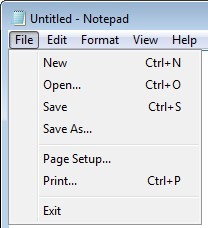
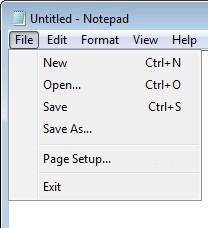
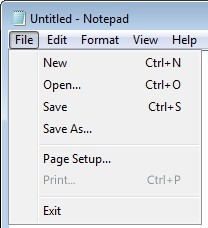
- but limiting information visible on screen increases load on working memory: too little information displayed ![]() people take more _____ (Davies, 1993)
people take more _____ (Davies, 1993)
- solution? ________: explain what problem is/show how to fix it
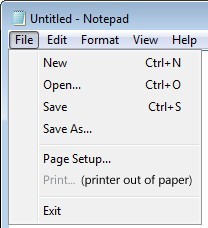
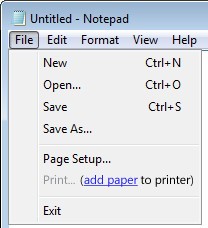
- EID changes cognitive task to perceptual one:
vs. |
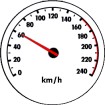 |
Pros & Cons:
![]() evidence: improves performance compared to conventional interfaces
evidence: improves performance compared to conventional interfaces
![]() requires substantial time and effort to analyze the work domain, determine what information is relevant/a good abstraction, and choose the interface form
requires substantial time and effort to analyze the work domain, determine what information is relevant/a good abstraction, and choose the interface form
![]() difficult to discern _____ of problem when all information is
perceptually integrated; may lead to __________ (“clicking, not
thinking”)
difficult to discern _____ of problem when all information is
perceptually integrated; may lead to __________ (“clicking, not
thinking”)
![]() operators may want raw data and higher-level information
operators may want raw data and higher-level information
Geekonomics: The real cost of insecure software (Rice, 2007):
• 1947: first computer “bug”
- ____ found inside relay of Harvard’s Mark II computer
• 1962: Mariner 1 Venus space probe rocket went off course
- had to be destroyed; cost = US$80M
- character had been dropped from a line of coded computer instructions
• 1990: AT&T’s phone network went down for 9 hours
- 50 million calls blocked
- due to missing _________ in computer program
• 1996: software defects in a Boeing 757 caused a crash that killed 70 people
• 2003: software vulnerability contributed to the largest U.S. power outage
• 2005: over 23,000 Toyota Priuses were recalled for software errors that could cause the cars to shut down at highway speeds
• 2022: annual cost of poor software quality: US$2.41 trillion (Consortium for Information and Software Quality, 2022)
• 1000: end of the world expected:
“On new year’s eve, 1000 AD, a crowd gathered at Rome, awaiting the end of the world. Midnight came, nothing happened. The pope, Sylvester II, blessed the crowd and sent them home” (Lane, 1984, p.70)
Year 2000 (“Y2K”) design ____ (not bug) is threefold:
1. ____ storage:
- date represented as “65” instead of “1965”
- problem: date of “00” (“2000”) interpreted as “1900”
- minimized expensive memory/disk space; efficient
- didn’t foresee programs operating beyond 1990s
2. ____-____ calculations:
- Y2K is leap year special case; occurs every 400 years
- a year is a leap year if it is divisible by four, but if divisible by 100 it is not a leap year, but if divisible by 400 it is a leap year
3. special meanings for _____:
- date fields used to provide special functionality:
e.g., 9/9/99 or April 9, 1999 (99th day of 1999)
- could represent:
“save this data item forever”
“remove this data item automatically after 30 days”
“sort this data item to the top of the report”
Levels of the System:
1. ________/firmware: contains system clock
- BIOS (basic input/output system): chips on motherboard
- replace chips--if manufacturer still exists
2. _________ ______ (OS): interface between user & hardware
- files are time/date stamped
- may (partially) compensate for BIOS errors
- OS vulnerabilities:
• Windows 98/MS-DOS 7.10 works until Jan. 1, 2108
• original Macintosh works until 6:28:16 a.m., Feb. 6, 2040
• Mac OS 9 works until the year 29,940
3. runtime libraries: provide extended functionality
- extra layer between applications and OS
4. applications (“apps”: word processors, databases, etc.)
- Microsoft Word v.5 crashes
5. ______ code: macros, proprietary software
- older “legacy” software is suspect
6. data interfaces: different types of computers interconnect
- century/millennium data may be lost in transfer
Potential complication: partial breakdown
- computer appears to be functioning _________--but isn’t!
Results:
• Pre-1999:
- 1992: Mary Bandar invited to join kindergarten--she was born in “88” (____!)
- credit cards: many with “00” expiry dates rejected
• Canada:
- public school system payroll miscalculations
- ______ door systems failed in British Columbia
- department of motor vehicle system malfunction
- switching station failed in Oshawa
- individual portfolio malfunctions on Toronto Stock Exchange website
• Worldwide:
- Oak Ridge _______ weapons plant in Tennessee
- US Air Force Keyhole photo recon satellites, and Lacrosse all-weather imaging spy satellites
- heating system of apartment in South Korea
- payrolls, credit cards, X-ray machines, computer terminals affected
Estimated costs:
- Gartner Group (1997): US$300-600B (global); economy slowed by 0.3%
- Lloyd’s of London (1998): litigation projected to top US$1T--but legislation limited liability
e.g., pain/emotional distress claims limited to US$250,000
- Software Productivity Research (1996): total cost US$3.6T
- __________ may have prevented Y2K reports
- the big question:
Was the problem _____________--or handled well?
How to deal with a foreseen problem:
1. ________/Awareness
- institute schedule for compliance
2. _________/Assessment
- triage: mission critical systems (![]() cessation of business); significant systems (
cessation of business); significant systems (![]() major disruptions); minor inconveniences; extraneous systems
major disruptions); minor inconveniences; extraneous systems
- “end-to-end”: from user interface to underlying code
- replace systems
3. _______:
- don’t implement fixes on a Monday morning
- don’t use primary database (use backup)
4. __________:
- include contingency (roll-back) plans
5. Fallout:
- effects of public fear (“causal ______”)
Future known problems include:
• Q-day (when quantum computers become powerful enough to break widely used encryption methods)
• future pandemics (“Disease X”)
• peak oil
• water depletion
• environmental disasters
• antibiotic resistant bacteria
• catastrophic AI risks